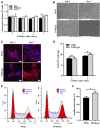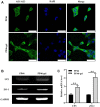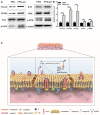Gelatin-grafted tubular asymmetric scaffolds promote ureteral regeneration via activation of the integrin/Erk signaling pathway
- PMID: 36686259
- PMCID: PMC9849368
- DOI: 10.3389/fbioe.2022.1092543
Gelatin-grafted tubular asymmetric scaffolds promote ureteral regeneration via activation of the integrin/Erk signaling pathway
Abstract
Introduction: The repair of a diseased ureter is an urgent clinical issue that needs to be solved. A tissue-engineered scaffold for ureteral replacement is currently insufficient due to its incompetent bioactivity, especially in long-segment abnormalities. The primary reason is the failure of urothelialization on scaffolds. Methods: In this work, we investigated the ability of gelatin-grafted tubular scaffold in ureteral repairment and its related biological mechanism. We designed various porous asymmetric poly (L-lactic acid) (PLLA)/poly (L-lactide-co-e-caprolactone) (PLCL) tubes with a thermally induced phase separation (TIPS) method via a change in the ratio of solvents (named PP). To regulate the phenotype of urothelial cells and ureteral reconstruction, gelatin was grafted onto the tubular scaffold using ammonolysis and glutaraldehyde crosslinking (named PP-gel). The in vitro and in vivo experiments were performed to test the biological function and the mechanism of the scaffolds. Results and Discussion: The hydrophilicity of the scaffold significantly increased after gelatin grafting, which promoted the adhesion and proliferation of urothelial cells. Through subcutaneous implantation in rats, PP-gel scaffolds demonstrated good biocompatibility. The in vivo replacement showed that PP-gel could improve urothelium regeneration and maintain renal function after the ureter was replaced with an ∼4 cm-long PP-gel tube using New Zealand rabbits as the experimental animals. The related biologic mechanism of ureteral reconstruction was detected in detail. The gelatin-grafted scaffold upgraded the integrin α6/β4 on the urothelial cell membrane, which phosphorylates the focal adhesion kinase (FAK) and enhances urothelialization via the MAPK/Erk signaling pathway. Conclusion: All these results confirmed that the PP46-gel scaffold is a promising candidate for the constitution of an engineered ureter and to repair long-segment ureteral defects.
Keywords: MAPK/ERK pathway; gelatin; tissue engineering; ureter; urothelialization.
Copyright © 2023 Song, Fang, Mao, Ye, Yan, Ma, Shi, Hu, Zhu and Cheng.
Conflict of interest statement
The authors declare that the research was conducted in the absence of any commercial or financial relationships that could be construed as a potential conflict of interest.
Figures







Similar articles
-
Heparinized PLLA/PLCL nanofibrous scaffold for potential engineering of small-diameter blood vessel: tunable elasticity and anticoagulation property.J Biomed Mater Res A. 2015 May;103(5):1784-97. doi: 10.1002/jbm.a.35315. Epub 2014 Sep 16. J Biomed Mater Res A. 2015. PMID: 25196988
-
Tissue-engineered PLLA/gelatine nanofibrous scaffold promoting the phenotypic expression of epithelial and smooth muscle cells for urethral reconstruction.Mater Sci Eng C Mater Biol Appl. 2020 Jun;111:110810. doi: 10.1016/j.msec.2020.110810. Epub 2020 Mar 3. Mater Sci Eng C Mater Biol Appl. 2020. PMID: 32279818
-
The effect of blending poly (l-lactic acid) on in vivo performance of 3D-printed poly(l-lactide-co-caprolactone)/PLLA scaffolds.Biomater Adv. 2022 Jul;138:212948. doi: 10.1016/j.bioadv.2022.212948. Epub 2022 May 29. Biomater Adv. 2022. PMID: 35913240
-
Fabrication and Cell Responsive Behavior of Macroporous PLLA/Gelatin Composite Scaffold with Hierarchical Micro-Nano Pore Structure.Nanomaterials (Basel). 2015 Mar 25;5(2):415-424. doi: 10.3390/nano5020415. Nanomaterials (Basel). 2015. PMID: 28347020 Free PMC article.
-
Electrospun silk fibroin/poly(lactide-co-ε-caprolactone) nanofibrous scaffolds for bone regeneration.Int J Nanomedicine. 2016 Apr 11;11:1483-500. doi: 10.2147/IJN.S97445. eCollection 2016. Int J Nanomedicine. 2016. PMID: 27114708 Free PMC article.
Cited by
-
Adipose stem cells in tissue regeneration and repair: From bench to bedside.Regen Ther. 2023 Oct 11;24:547-560. doi: 10.1016/j.reth.2023.09.014. eCollection 2023 Dec. Regen Ther. 2023. PMID: 37854632 Free PMC article. Review.
-
AxiWorm: a new tool using YOLOv5 to test antiparasitic drugs against Trichinella spiralis.Parasit Vectors. 2025 Feb 2;18(1):36. doi: 10.1186/s13071-025-06664-8. Parasit Vectors. 2025. PMID: 39894842 Free PMC article.
References
-
- Al-Maawi S., Rother S., Halfter N., Fiebig K. M., Moritz J., Moeller S., et al. (2022). Covalent linkage of sulfated hyaluronan to the collagen scaffold Mucograft® enhances scaffold stability and reduces proinflammatory macrophage activation in vivo . Bioact. Mater 8, 420–434. 10.1016/j.bioactmat.2021.06.008 - DOI - PMC - PubMed
-
- Dalton G. D., Carney S. T., Marshburn J. D., Norford D. C., Howlett A. C. (2020). CB1 cannabinoid receptors stimulate gβγ-GRK2-mediated FAK phosphorylation at tyrosine 925 to regulate ERK activation involving neuronal focal adhesions. Front. Cell Neurosci. 14, 176. 10.3389/fncel.2020.00176 - DOI - PMC - PubMed
LinkOut - more resources
Full Text Sources
Miscellaneous

